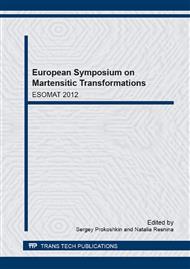p.292
p.297
p.301
p.306
p.311
p.316
p.321
p.326
p.332
Thermomechanical Fatigue Behavior of NiTi Wires
Abstract:
Applications of the functional, smart materials SMA need a careful evaluation of the working conditions and fatigue life. Structural fatigue failure in NiTi usually comes from a surface defect inducing crack growth, and this means that fatigue has to be studied for concrete applications, with the correct samples, as the state of the material presents size effects. Testing machine experiments on Ni-rich pseudoelastic wires indicate that the main parameter controlling the fatigue life in the traction-traction experiments is the effective stress on the NiTi wire. Long wire life (in the million cycle regime) can be achieved under limited stresses (under 170 MPa) in traction-traction tests. Also, experiments have been done on thermal actuation of NiTi wire under traction at constant load. Long actuator life (larger than 400000 cycles) can be achieved at low stresses (around 100 MPa), coherently with the results from the mechanical cycling.
Info:
Periodical:
Pages:
311-315
Citation:
Online since:
January 2013
Price:
Сopyright:
© 2013 Trans Tech Publications Ltd. All Rights Reserved
Share:
Citation:


